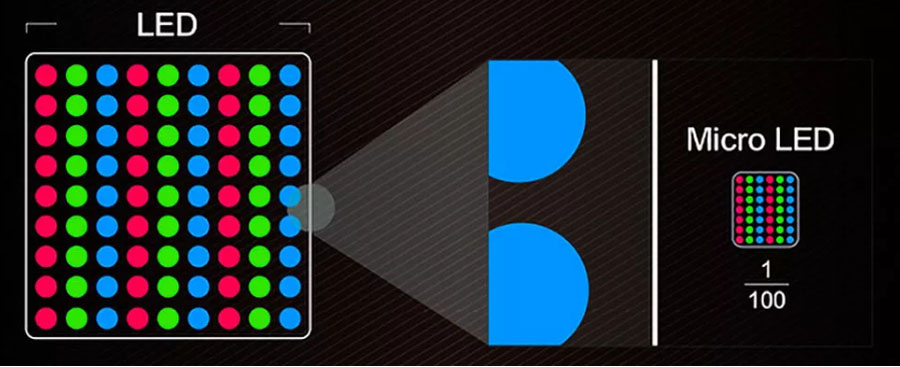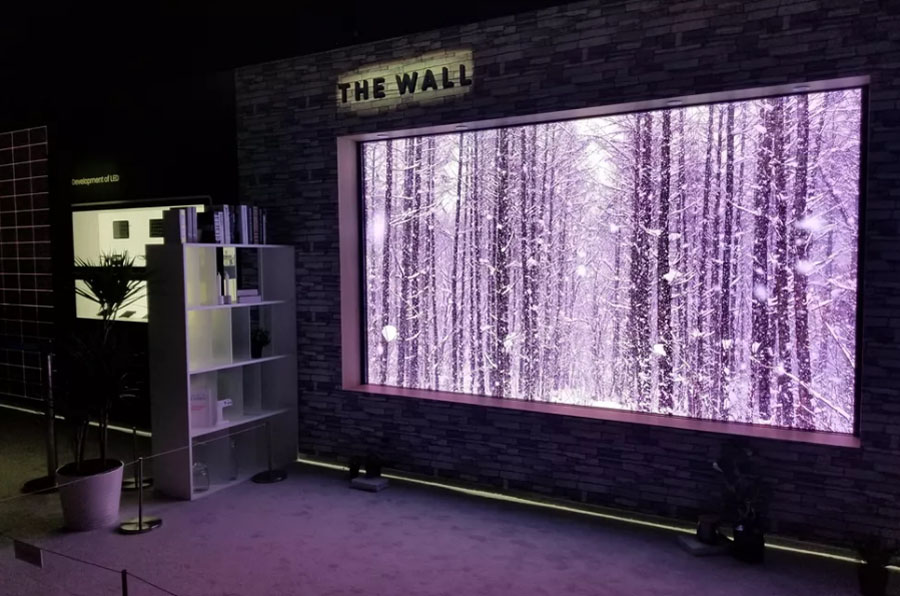Apple is the first to develop displays for its devices. These will be the displays of the new generation.
Apple has been using ready-made displays from other manufacturers for their gadgets for many years. Apple Watch watch screen makes LG Display. The OLED screen for iPhone X, the first such screen in the Apple smartphone, was supplied by Samsung. "Apple" company only slightly adjusts the displays for their devices - for example, calibrates the iPhone screens to improve color reproduction. But this is where her engagement with displays ends.

Now, according to Bloomberg sources , Apple has decided that dependence on shipments from other companies makes it vulnerable. And since it is the richest company on the planet (with $ 252 billion in ready cash), it is time to spend part of the reserves, and still develop your own screen. Yes, so that competitors in the market have no chance. And this means - to create your own technology for displays, the most advanced and cool, and then it should be properly patented. Samsung, LG and others are slightly shocked right now. On rumors of such a decision by Apple alone, their shares began to fall.
For the first time, Apple has been designing and developing its own displays - at a secret production base not far from its main office in California. About this agency Bloomberg reported "sources familiar with the situation." Those. the giant is going to make billions of investments in the creation of a new generation of MicroLED screens. Such displays will contain other light-emitting components than modern OLED screens, and will make future gadgets thinner, brighter and less energy-intensive. Already there is talk that MicroLED is the first fundamentally new technology for displays since it appeared in OLED smartphones in 2013.

Apple Secret Factory in Santa Clara. March 2018
New displays are an order of magnitude more difficult to produce than OLED screens. As pixels, MicroLED uses not organic LEDs, but diodes based on gallium nitride. They are extremely small in size, less than a tenth of the thickness of a human hair (it’s not for nothing that the name contains the word “micro”). Faced with the complexity of the process, Apple almost abandoned the project about a year ago. But now engineers have found a solution, and the technology is almost ready for mass production. According to sources within the company, users will be able to see it in the gadgets in a couple of years, if the screens do not reveal any problems.
An ambitious project, worth billions of dollars in investment, is part of Apple’s strategy to bring back the design of key components to devices. The company has been creating chipsets for its devices for several years. Apple's new move is expected to seriously hurt Samsung’s, LG, Sharp and Japan Display businesses, producing screens for smartphones, tablets and smart watches of the company, as well as cuts in Synaptics profit making interfaces for connecting the chipset to the screen.
When rumors of such a decision Apple first appeared last week, the shares of dozens of companies fell by 5-15%. The company Universal Display (-16%), which holds patents for OLED technology, suffered the most. Investors were scared that MicroLED could eventually make them unclaimed. Samsung suffered the least (-2%), which has its own MicroLED-developments.

Comparison of sizes of traditional LEDs and MicroLED
')
Controlling the MicroLED technology will allow Apple to stop fearing competition from Samsung, which is leading in the production of displays, says Ray Soneira, owner of the screen-testing company DisplayMate Technologies. “This is one of the last chances of those. the giant stand out against the background of Korean and Chinese companies that are winning a growing market share. Anyone can buy a device with an LCD or OLED screen. But MicroLED can only belong to Apple. ”
On the way - a lot of potential obstacles. Mass production of new types of displays will require new equipment, which will also need to be first developed and released. These are billions of dollars in costs that may not pay off - if they find a critical problem on the screens or if another company creates an even more advanced type of display.
Apple's California factory is too small for mass production, but for now the company wants to keep its technology under lock and key. To eliminate any possible leaks, the screens and methods of their production are not disclosed even to partners in Asia - at whose enterprises, most likely, displays will be produced as a result in order to reduce their cost.
The secret initiative, as sources say Bloomberg, received the code name T159. She is headed by Lynn Yongs , one of the company's veterans, who helped with the creation of the first touchscreens for the iPhone and iPad. Under his control - the production workshop of 5800 m2, the first and only of this type in Apple. The company is located on an unremarkable street in Santa Clara, California, 15 minutes from the Apple Park campus in Cupertino. Approximately 300 engineers work there on the first MicroLED displays (except for the concepts for TVs, which Samsung showed at the end of February). Such displays will be 30 times brighter than OLED screens, will consume less energy and will last much longer in service.

Apple Factory in Taiwan helping with the project
Nearby is another plant responsible for the so-called “LED transmission”: the process of transferring individual pixels to the MicroLED screen. Apple received a patent for this technology with the purchase of a startup LuxVue in 2014. About a year after this deal, Apple opened the display development department, and according to rumors, LuxVue’s engineers were the backbone of the deal. To test the capabilities of these developers, the company first secretly launched several LCD displays in its Technology Center in Taiwan, and engineers from the Santa Clara factory had to modify the iPhone 7 using these “parts”. So that smartphones can work normally, and in quality (contrast, color reproduction, processing speed of commands, etc.) are not inferior to this. Apple executives tested the resulting samples, and a few weeks after that, they provided engineers with full funding to create displays with MicroLED.
Due to the complexity of building an entire screen factory, Apple took several months to commission its secret factory in California. And only in recent months, engineers have the confidence that they will be able to replace the screens from Samsung and other suppliers over time. At the end of 2017, they were the first to manage to manufacture fully functional MicroLED screens for the future Apple Watch. Probably, these will be the first devices with the new technology. They will not reach consumers for at least two more years, so far these are only prototypes. However, according to rumors, Apple is very pleased with these results. Now she can start reducing her dependence on manufacturers.
The Apple Watch prototypes with MicroLED cannot yet be worn: the screens simply connect to the computer outside the watch. But engineers can test their responsiveness, and evaluate other characteristics. According to the person with access to the inside of the plant, the most noticeable is that they are much brighter than the current watch screens (they contain an OLED matrix). It is also much easier for developers to control individual colors during calibration.
The technology most likely will not reach the iPhone in the next 3-5 years. The smartphone line remains the company's main “cash cow”, and, considering how many problems there were with the innovations in the iPhone X, Apple executives want to make sure that this time the technology is really ready. First, it will be tested on the Apple Watch - just like with OLED screens (they appeared in the watch in 2014, and on the iPhone, users only saw them at the end of 2017).

Samsung's Concept TV with MicroLED technology, demonstrated at CES-2018. Diagonal - 146 inches, cost - about $ 100 thousand
Creating MicroLED displays is an extremely complex process. Depending on the screen size, they may contain millions of individual pixels. In each - three subpixels, red, green and blue LEDs. Each of these microscopic LEDs must be individually created and calibrated. All of them come from the donor plate and should be transferred to the MicroLED screen. Apple used to buy these plates from third parties, like Osram Licht and Epistar Corp., and only in recent months has it learned to “grow” its own LEDs. The donor plates are created in a perfectly clean room inside the Santa Clara plant.
At the same production, prototypes of MicroLED displays are assembled, up to connecting the screen to glass. Some components are manufactured in a factory in Taiwan. Apple is also developing its own thin-film transistors and screen drivers, key components in display assembly. Now the plant in Santa Clara can produce several full-featured screens under the Apple Watch (up to 2 inches in diagonal) per day. Before mass production, especially screens for the iPhone, is still far away.
As long as the world is not ready to see MicroLED, Apple will still play the role of a proponent of OLED displays in public. This fall, the company plans to launch its second iPhone with OLED, a giant 6.5-inch model (the iPhone X had a 5.8-inch screen). Also, work is underway to expand the production of OLED from Samsung and include LG in this business.
You can read more about the MicroLED technology here .
PS Buy Apple equipment is best in the US, it is much cheaper there. Apple sells the same iPhone X in Russia for 79,990 rubles ($ 1,392). In America, it costs $ 1,085 . Save, and Pochtoy.com will deliver any purchases to Russia. From $ 8.99 per pound. If you register with the code Geektimes, you are immediately credited to the account $ 7.
Source: https://habr.com/ru/post/411115/
All Articles